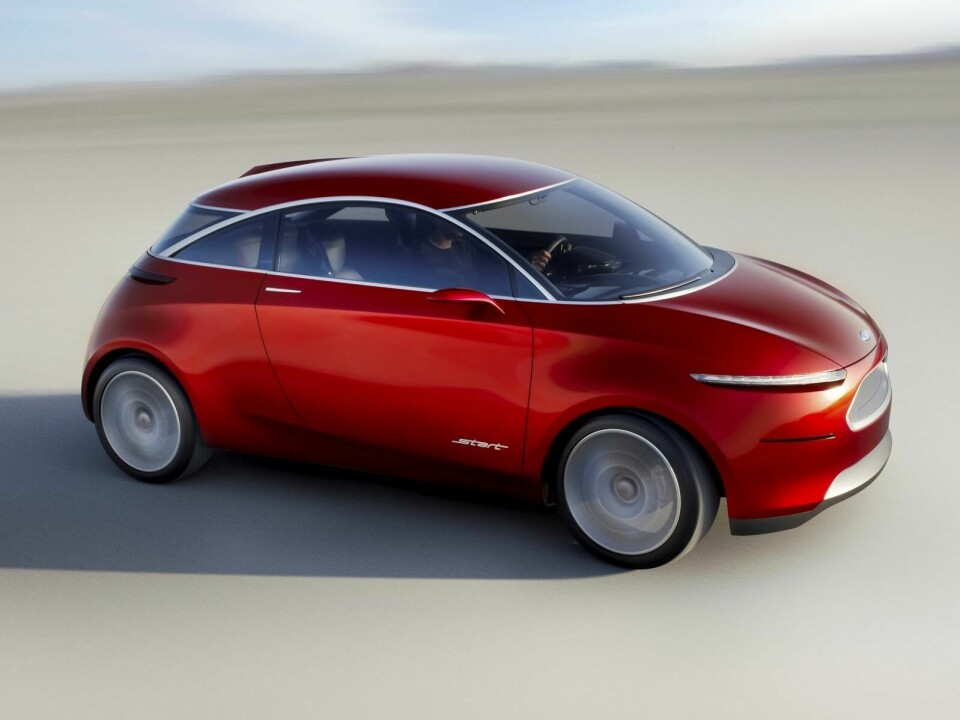
Concept Car of the Week: Ford Start (2010)
The Ford Start was one of the stars at the 2010 Beijing Motor Show










While we’re painfully aware of the result of Ford’s platform-sharing tie-up with Fiat for the Ka and 500 respectively, the Start concept, unveiled at the 2010 Beijing Motor Show, offered a glimpse of what might have been.
The Start was the work of Ford’s Strategic Concept Group in Irvine, California, headed by Freeman Thomas - a chief contributor to one of the purest and iconic designs of recent times: the first Audi TT. Given that Thomas steered the project, it’s no surprise that the Start went against the trend of the time for complicated and often convoluted shapes, instead offering a form that could be sketched in just three lines.
Here’s what Car Design News had to say about the Start after it made its appearance on Ford’s Beijing Motor Show stand:








Born in an avantgarde process - being first modeled and then sketched out - the Start is Ford’s answer to the growing demand for agile compact urban vehicles in a two-door, four-passenger configuration. Based on the Fiat 500/Ford Ka platform, the Start shares its 2300mm wheelbase with the Ka. The chassis was heavily modified with aluminum and lightweight solutions that allow for unique styling features such as the floating B-pillar and the see-through C-pillar.
The Start is longer and significantly lower and wider than the production models with which it shares its platform. These dimensional changes combine with the effect created by the near-horizontal beltline to lend the car a highly authentic feel. Very balanced volumes and refined proportions create a modern stance with a sporty, yet elegant, look.
To strengthen the sense of balance in the side view, careful consideration has been paid to the relationship between the shallow DLO and the wheels, with the brushed steel arch that defines the lateral glass surface playing a key role in connecting the center of the front and rear wheels. Pronounced wheelarches, housing 17-inch pressed alloys, further accentuate the stance and visually ground the car.
Note how when viewed in profile every line has a meaning; the three main feature lines, DLO arch and the two bone lines (shoulder line and lower flank line), together with the rear screen angle, all link to an imaginary vanishing point behind the car.
The minimalist approach is also evident in the Start’s face. The Ford trapezoidal air intake - here without a grille - is moved to the upper mask. Sleek, horizontal headlamps endow a responsive yet relaxed demeanor, proving that in car design it’s not just circular headlamps and smiley grille graphics that can be used to create a pleasant facial expression. Head and taillamps wrap around the corners of the car, creating visual width and exaggerating the stance with their sweeping effect. The rear provides a great lesson in how to create a visually impressive graphical mask. All lines converge at the center point, the effect magnified by some immaculate detailing.
The interior feels more generous and functional than other vehicles in this segment, and perfectly compliments the exterior with its high quality look and feel. A fine balance is achieved between organic elements - such as the wave-ribbing in the seats and headliner - and analog, industrial elements such as the IP, which features a driver-orientated interaction zone and a six-inch smartphone-like screen in the center console that controls other vehicle functions.
Efficient use of space is apparent everywhere, helped by the wheels being pushed as far as possible to the corners of the car. This continues with the flat cabin floor, the suspended dash devoid of a tunnel, the gear lever in the center console, the thin front seat that floats on a center rail to free up foot room for rear passengers, and the one-piece rear seat that features an unbroken curvature simulating a lounge space. These features combine with the visibility afforded by the large glass area, floating door glass and 180-degree fixed backlight to make the interior environment a pleasant space.
A recurrent symmetrical theme concealed in elements both of the exterior (roof fin, exhaust) and interior (dash center fin, seat stripes and bucket center fin) simply magnifies the impression that many superfluous components have been reconsidered and eliminated in pursuit of a minimalistic approach.
Despite being the product of the now-ubiquitous One Ford strategy, the Start’s forward-thinking take on small-car design hasn’t become a production reality. Instead, it has been rationalized into the new Ka, aimed at developing, extremely cost-sensitive markets. But, if we fast-forward to 2015, with the world’s economies recovering and markets developing all the time, we’d still like to imagine that while it’s currently stopped, the Start could return to kick-start a small-car revolution one day soon.
First Seen 2010 Beijing Motor Show
Length 3682mm
Width 1690mm
Height 1416mm
Wheelbase 2300mm
Engine 1.0-liter three-cylinder EcoBoost



